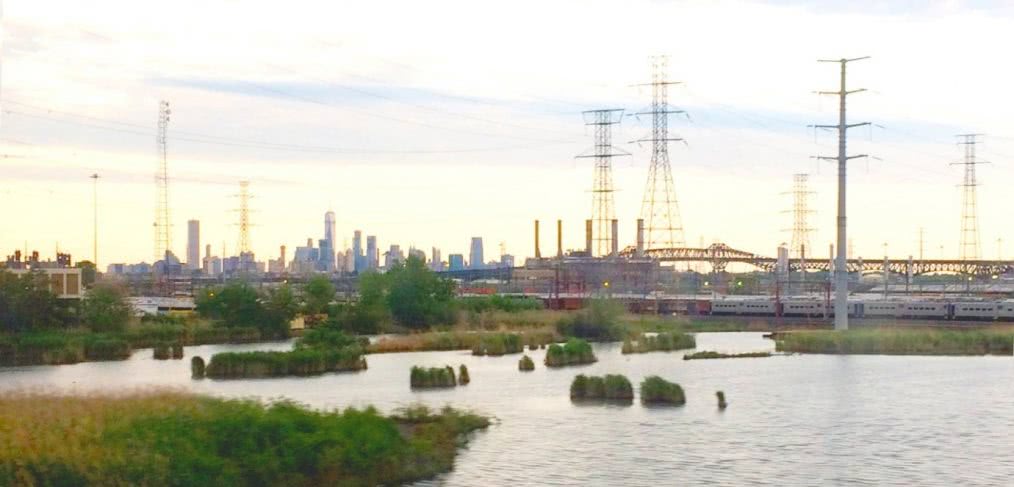
Parks With Purpose
APRIL 3, 2018 BY Monica Streeper
I quickly captured the scene above with a shaky iPhone from the window of a moving train. While it might not be what my generation would consider particularly Instagram worthy, I like it because of the way it puts the New York City skyline into an entirely new context. The iconic buildings, seen from a distance, become part of a strange composition. While the scene is unmistakably urban, wetlands in the foreground merge with rails, bridges and power lines. The landscape collides with infrastructure in a way that dwarfs the cultural capital of New York City beyond.
The photo resonates with me, a landscape architect for CallisonRTKL’s planning and urban design group here in New York, because in a way, it represents our practice from my perspective. While buildings are at the heart of what my colleagues and I focus on daily, for me, they are one component of a complex urban environment. I have come to appreciate this more as our studio works with clients to identify feasible, valuable uses for what we refer to as “surplus properties,” or neglected urban spaces. The United States is full of them: the coastlines of cities large and small are dotted with former industrial sites owned by oil and gas companies that are no longer in use, but exist in a state of limbo, often because the environmental remediation required is rigorous and daunting.
This is where our team comes in. We work to unlock the potential of a site, setting in motion a comprehensive strategy to pave the way for a positive future that delivers tangible benefits to the surrounding community, as well as the owners. Sound like a tall order? Well, yes, you are correct. It is a working model that we tweak and refine with each property and client with whom we engage, and we continue to gain traction as we build on past successes.
For me, the most interesting part is planning for the parks and open spaces incorporated into these projects. Nearly all of them are located along a beautiful body of water with unspoiled views and indelible character tied to their industrial past; they’re gritty and interesting in a way that landscape architects love. Since the properties are privately owned and many have been closed for years, the waterfronts offer completely fresh opportunities for creating an experiential public realm that has never been available before—as well as potential new vantage points along pedestrian paths and promenades that are Instagram worthy.
Since locals are often familiar with these projects and their former industrial uses, we often plan to retain some of the existing foundation, cooling towers or treatment basins and creatively integrate them into the design—for example, using the edge of an old cooling pond to frame a new community garden. This sort of adaptive reuse links the past to the future and celebrates a site’s transformation.
As many wild and beautiful opportunities exist for surplus properties, there are just as many challenges. I mentioned remediation, and let’s not overlook the fact that these properties are contaminated with a cocktail of carcinogens containing more ingredients than a can of soda. While this implies limits of a practical nature, it also elevates the importance of good planning for open spaces. Parks can effectively protect against contamination, as well as flooding, and any new buildings or development will require both. While flood protection within park design is not a new idea, we work to take it to the next level by tackling those issues early in the process and pushing the benefits of these waterfront parks even further. For this to work, we need soil to do triple duty, providing a cap for contamination, a clean growing medium for plants and a flood protection berm. It’s not always as straightforward as that, but it is the goal in terms of maximizing the benefits of park space and delivering the greatest value for our clients.
You might wonder how any of this benefits our clients; after all, aren’t they just looking to offload the property? The truth is, these properties aren’t worth very much without remediation and flood protection; they’re uninhabitable and would remain neglected wastelands. By preparing the grounds for new development and incorporating green space, it incentivizes owners to sell and developers to buy. Further, concentrating the buildable area means less intensive remediation, lower costs and a higher return. The best thing for the owner is the best thing for the community, and it presents our team with an exciting challenge to find elegant solutions for these problematic landscapes. As industrial sites are transformed into public parks and mixed-use destinations, our waterfronts and communities will continue to improve in health and in purpose.
